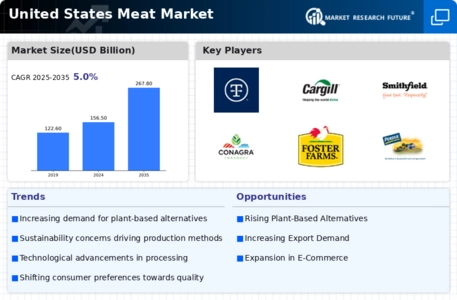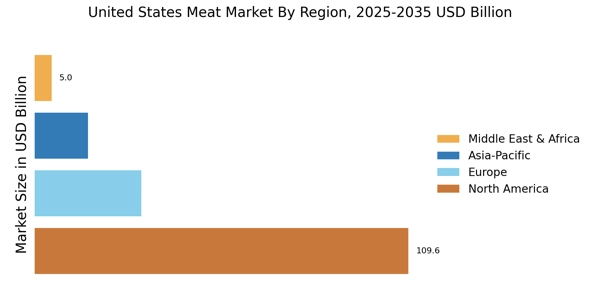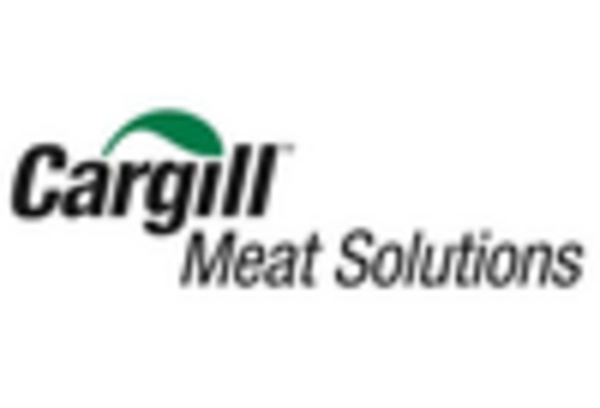The United States Meat Market is characterized by a dynamic competitive landscape, driven by evolving consumer preferences, sustainability concerns, and technological advancements. Major players such as Tyson Foods (US), JBS USA (US), and Cargill Meat Solutions (US) are at the forefront, each adopting distinct strategies to enhance their market positioning. Tyson Foods (US) emphasizes innovation in product offerings, particularly in plant-based alternatives, while JBS USA (US) focuses on expanding its global footprint through strategic acquisitions. Cargill Meat Solutions (US) is increasingly investing in digital transformation to optimize its supply chain and improve operational efficiency. Collectively, these strategies not only shape their individual trajectories but also influence the overall competitive environment, fostering a climate of rapid adaptation and responsiveness to market demands.
Key business tactics employed by these companies include localizing manufacturing and optimizing supply chains to enhance efficiency and reduce costs. The market structure appears moderately fragmented, with a mix of large-scale producers and smaller niche players. This fragmentation allows for diverse offerings but also intensifies competition among key players, as they vie for market share in an increasingly health-conscious consumer landscape.
In August 2025, Tyson Foods (US) announced a partnership with a leading technology firm to develop AI-driven solutions for meat processing. This strategic move is likely to enhance operational efficiency and reduce waste, aligning with the growing trend towards sustainability in food production. By leveraging AI, Tyson Foods (US) aims to streamline its processes, potentially setting a new standard in the industry for efficiency and environmental responsibility.
In September 2025, JBS USA (US) completed the acquisition of a regional meat processing company, which is expected to bolster its market presence in the Midwest. This acquisition not only expands JBS USA's operational capacity but also enhances its ability to meet local demand more effectively. Such strategic expansions are indicative of a broader trend where companies seek to consolidate their positions in key markets, thereby increasing their competitive edge.
In July 2025, Cargill Meat Solutions (US) launched a new line of sustainably sourced meat products, responding to consumer demand for transparency and ethical sourcing. This initiative underscores Cargill's commitment to sustainability and positions the company favorably among environmentally conscious consumers. By prioritizing sustainable practices, Cargill Meat Solutions (US) is likely to attract a growing segment of the market that values ethical consumption.
As of October 2025, the competitive trends in the United States Meat Market are increasingly defined by digitalization, sustainability, and the integration of advanced technologies. Strategic alliances are becoming more prevalent, as companies recognize the need to collaborate in order to innovate and meet consumer expectations. Looking ahead, competitive differentiation is expected to evolve, shifting from traditional price-based competition to a focus on innovation, technological advancements, and supply chain reliability. This transition may redefine the competitive landscape, compelling companies to adapt swiftly to maintain their market positions.


















Leave a Comment